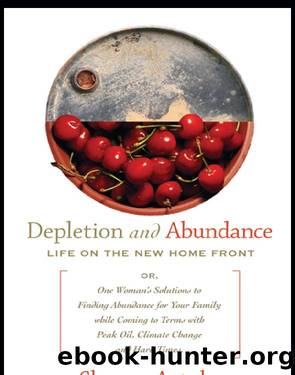Depletion and Abundance : Life on the New Home Front (9781550923735) by Astyk Sharon

Author:Astyk, Sharon
Language: eng
Format: epub
Tags: SOC026000
ISBN: 9781550923735
Publisher: Perseus Book Group
Published: 2008-09-01T00:00:00+00:00
PART
Four
â¢
[Home Economics,
Home-Land Security ]
NINE
â¢
Little House in the Suburbs
Who has not found the Heaven below
Will fail of it above.
For angels rent the house next ours,
Wherever we remove
â EMILY DICKINSON
Iâve never loved any earthly thing so much.
â BARBARA KINGSOLVER
Home is Where You are Now
ONE OF THE THINGS THAT HAPPENS WHEN PEOPLE REALLY GRASP THE implications of our coming collective crisis is that they immediately think, âI have to grow all my food, cut all my own wood, mine salt from my backyard, grow flax so I can weave my own underwear and blacksmith my own automatic weapons!â The first reaction we all have is to try and protect our own, and to imagine that the right solution is to claim as much land as humanly possible on which to do it.
Speaking as someone who did move out of an urban location to begin a farm, I think for some people thatâs a really good response. If you love growing food, have some experience with it (although even that isnât wholly necessaryâI didnât have very much), want to live the country life and donât have ties keeping you in the city, then moving to a rural area and becoming more self-sufficient can be a good idea, and far be it from me to discourage you. (But you can probably reuse your current underwear for some time to come, and even if you have the forearms for blacksmithing, maybe start with a nice trellis instead of an automatic weapon.) We are going to need more farmers if weâre going to have real local food systems. Living in the country can be much cheaper than living closer to cities.
On the other hand, a big chunk of land often costs a lot of money, and not all of us have that. And living in the country has its downside. You may be more car dependent because it is harder to walk or bike to things and there are fewer public transportation options. There isnât always a large selection of jobs. And not everyone is cut out for a life in the woods.
That, however, is no bad thing. Because the simple fact is that there isnât enough land in the world to give everyone 20 acres, or even 10. And even if we could, it isnât necessarily a good ideaâthe âuse what you haveâ thinking that this book is based on suggests that people should mostly live in the houses weâve already built and adapt existing communities rather than building new houses in new places. Weâve already covered an awful lot of our precious arable land with housing â we canât afford to do much more of that.
Estimates suggest that over the next few years, Americans are going to have to produce more and more food on less and less land. In a 1994 paper, Cornell Professor David Pimentel and Mario Gampietro demonstrate that by 2050, most Americans will have only 0.6 acres of arable land available to grow their food. At the time of the study, the average Americanâs basic diet used 1.
Download
This site does not store any files on its server. We only index and link to content provided by other sites. Please contact the content providers to delete copyright contents if any and email us, we'll remove relevant links or contents immediately.
| Container Gardening | Hydroponics |
| Organic | Propagation & Cultivation |
| Topiary | Urban |
| Water Gardens & Ponds |
Turbulence by E. J. Noyes(7915)
The Thirst by Nesbo Jo(6795)
Gerald's Game by Stephen King(4548)
Be in a Treehouse by Pete Nelson(3913)
Marijuana Grower's Handbook by Ed Rosenthal(3602)
The Sprouting Book by Ann Wigmore(3528)
The Red Files by Lee Winter(3356)
The Remains of the Day by Kazuo Ishiguro(3278)
Sharp Objects: A Novel by Gillian Flynn(2936)
Christian (The Protectors Book 1) by L. Ann Marie(2642)
Organic Mushroom Farming and Mycoremediation by Tradd Cotter(2614)
The Culinary Herbal by Susan Belsinger(2414)
Stone Building by Kevin Gardner(2333)
The Starter Garden Handbook by Alice Mary Alvrez(2266)
Lilac Girls by Martha Hall Kelly(2241)
The Unlikely Pilgrimage of Harold Fry by Rachel Joyce(2200)
The Lean Farm Guide to Growing Vegetables: More In-Depth Lean Techniques for Efficient Organic Production by Ben Hartman(2075)
Urban Farming by Thomas Fox(2047)
Backyard Woodland by Josh VanBrakle(1877)
